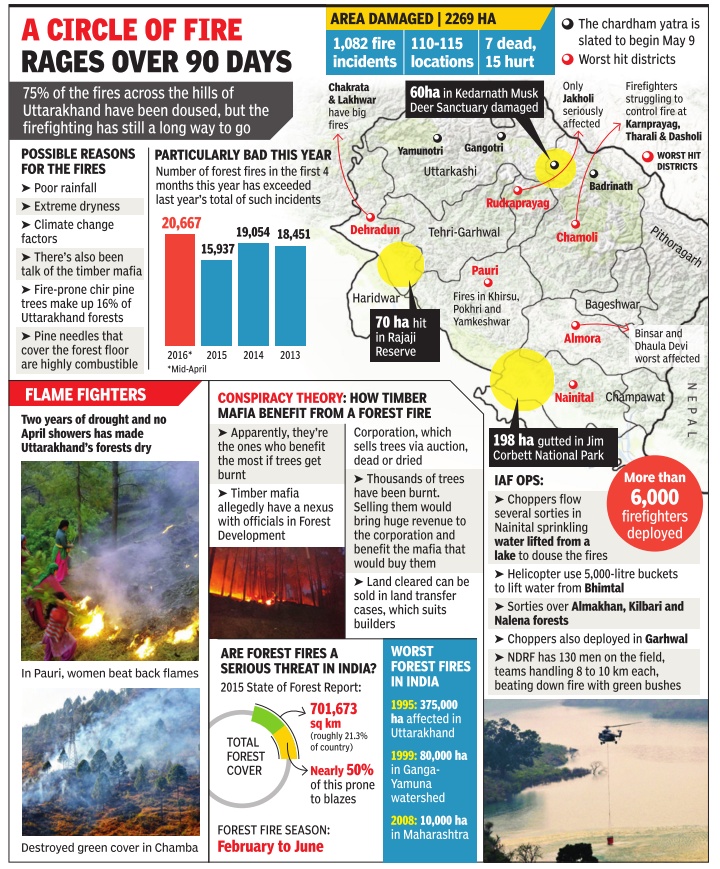Uttarakhand: Forest fires
This is a collection of articles archived for the excellence of their content. |
2016: Forest fires in Uttarakhand



Remedies, preventive steps
The Times of India, May 08 2016
Sharma Seema
Flames have destroyed 4,000 hectares of forests. From clearing pine needles to fire lines, here are some lessons that need to be learnt Finally , Uttarakhand's forests are no longer ablaze. The last of the fires were doused on Wednesday as the skies opened up and the rain gods took over the firefighting job from 11,000 personnel. By then, almost 4,000 hectares of the Himalayan state's forest cover had been gutted. The economic loss is still being calculated but the cost to the environment may be worse. Scientists warn that the black carbon from the fires may melt glaciers, cause a delay in the monsoons and pollute rivers. Massive soil erosion due to loss of the upper soil layer may also trigger floods if the monsoons are heavy this year.
Pine needles menace
What could have fanned the blaze? Was it the chir pine trees that make up 16-17% of the state's forests? The highly combustible pine needles from these trees are believed to be a major culprit in the fires spreading rapidly across the jungles. According to estimates, more than 3 crore tonnes of pine needles spread across the state's 53 lakh hectares of forest have not been cleared for years. “These pine needles are filled with resin and are ticking time bombs which can raze entire jungles with one flick of a matchstick,“ says environmentalist Anil Joshi. The high temperature and dry earth due to scanty rainfall in the winter months may have added further fuel.
Now, the forest department is asking villagers staying near forests to take away the pine needles -as many as they want. State forest secretary S Ramaswamy says the government is also exploring ways to utilize them as raw material in small electric projects, making of fuel bricks, etc.
Maintaining fire lines
Proven fire-preventing practices, some dating to colonial times, have been ignored. Over 4,500 fire lines -stretches kept vegetation-free to stop fires from spreading -most of which were set up by the British, have not been maintained for years. These are now overgrown with trees, which cannot be removed due to a Supreme Court ban on tree-felling above an altitude of 1,000 metres. Ramaswamy says there are now plans to clear the fire lines and the government is “waiting for a written order from the environment ministry“.
Fund crunch
Meanwhile, the blame game is on. “A Rs 8-crore fund was released from the CAMPA (Compensatory Afforestation Fund Management and Planning Au thority) scheme to make arrangements for fire control and clear the fire lines.The fund, which should have been made available to the forest department by January, came just a week ago when large parts of the forest had been gutted,“ says a senior forest official.
Delay in funds is a primary reason cited by officials for not containing the fires in time. “It is essential that funds are made available in December-January before the start of the fire season so that forest officials can be provided with the necessary equipment and sufficient manpower is at hand, especially fire watchers and labourers who can work on clearing old fire lines and making new ones,“ says Amit Negi, state disaster management secretary.
Who's accountable?
Experts say officials cannot shirk responsibility by citing insufficient funds.“In the 1950s, a forest ranger would have been denied promotion if his range had serious forest fires. Thermometers were maintained in each ranger's office to keep a watch on the temperature and sound an alert if it reached a certain threshold, above which there was a risk of fire,“ says R S Tolia, former chief secretary of Uttarakhand. “Of course, at that time, the area under a range was much smaller. Today , forest staff is burdened with management of much larger territories and has to deal with increasing political interference. But this is no excuse for lack of accountability on their part,“ he adds. An inquiry has been ordered by the chief secretary on why fire lines were not cleared in time.
Involve locals
Questions are also being asked about why the help of local communities residing near forests was not sought. Forest officials say almost all the fires were ignited by villagers who believe the fresh grass that grows from the ashes is nutritious, providing rich fodder for their cattle. “We chose to ignore their acts because we didn't want to antagonize them,“ says an official. But as fires spiralled out of control, 48 cases were registered in April against those responsible for starting them.
Rather than penalising, says Tolia, villagers should be co-opted into a participatory role. “There are almost 12,000 van panchayats, governing bodies of villagers to manage forests near their village. They can play an active role in fire dousing or curbing illegal activities if coordination is smooth,“ he says.